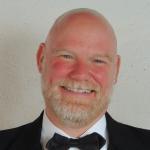Jeff Barnhart: Welcome back, dear readers. This month we’re continuing our discussion of a unique traditional jazz group that had its heyday in the 1960s in California, the El Dorado Jazz Band! Hal, at the end of last month’s column, you indicated there was about to be a personnel change. Could you illuminate the details and take us into the music?
Hal Smith: Actually, Jeff, this next track has one of the musicians who subbed for a couple of the “regulars” from time to time: Robin King. He plays brass bass on this track, though he also played trombone with the El Dorado band on occasion. (I believe he played with an early version of the South Frisco Jazz Band as well). He has a softer sound than Pete Kier and the horn he is playing sounds more (to me) like a tuba than a helicon, as Kier played. The song is “Storyville Blues”—written as “Those Draftin’ Blues” by Maceo Pinkard, adapted by Bunk Johnson and “finalized” by Turk Murphy. El Dorado’s interpretation is based on Turk’s, especially with Al Crowne playing lead on the verse and the inclusion of the chromatic melody line after the last solo. There is another great live recording of the EDJB playing this on William Miskell’s “Item-1” LP.
“Cake Walking Babies” introduces another frequent guest with the band: washboardist Betty Hamilton. If my ears are accurate, there are more musicians in the rhythm section than on the front line! Count ’em: Dan Ruedger, Clark Huddleston, Mike Fay, Robin King, Bob Raggio, and Betty Hamilton—as opposed to only three horns! In any case, this is a blazing-hot version of a traditional jazz warhorse. There is an absolutely beautiful clarinet solo by Mike Baird. Next is an almost stream-of-consciousness vocal by Papa Ray and Al Crowne, with barely a hint of melody. Al Crowne’s fine trombone solo is followed by a rag-a-jazz chorus by Papa Ray, then a banjo duet with lots of nice syncopations, a reprise of the vocal (verse and chorus) and once again the melody is avoided! The next-to-last chorus simmers before the horns serve up a bubbling hot last chorus—finished off with one of Papa Ray’s patented double endings. By the way, there is a killer version of “Cake Walking Babies” on that same Item-1 LP that has “Storyville Blues.” If you ever see that LP on eBay, discogs.com, or CDandLP…buy it!
“Dallas Blues” has the same lineup as the previous track. The band plays it as a hot stomp. Mike Baird sails through two terrific choruses, followed by Papa Ray (briefly quoting “See See Rider”). I think Al Crowne’s trombone choruses are some of the best on this CD. Dan Ruedger shouts out both lyrics to the chorus with repeats before the full band comes charging back in for an ensemble chorus, two verses and a final chorus, with Papa Ray leading the way throughout and into a definitive double ending.
What stands out for you on these three tracks, Jeff?
JB: I’ve always loved “Storyville Blues,” Hal, and it’s great to be reminded it was originally under a different title. I was only familiar with the Turk rendition; while the EDJB references Turk’s version, there is so many unique elements going on here! First, it’s still remarkable to me how bassist Mike Fay and (now) tubist Robin King manage to play together without stepping all over each other’s parts. King plays simpler lines than does heliconist Pete Kier so that helps a good deal, but it’s really illustrative of how sensitive (and open-minded) a player was Mike Fay. I really enjoy Al Crowne’s work here, both on the verse and on his solo chorus leading into that final ascending-melody ride. He takes the tag customarily taken by trumpet at the end as well. Mike Baird’s solo, starting so low and pretty and then soaring up to that high note, rocked me back on my heels, as it apparently did on of his bandmates (who yelled what I hear as “Owwhh, Shit, Mike!)!! Ronnei’s cornet chorus is lyrical, peppered throughout with those hot two-note phrases he favored. The only thing I noticed is that the tempo gets steadily faster from start to finish; this band, as we’ve noted in part I, plays either very fast or very slow, with medium tempos tending to gravitate in one direction or the other. However, it’s a tribute to how much there is to listen to here that the quickening of the tempo doesn’t detract from the overall exhilirating effect for the listener.
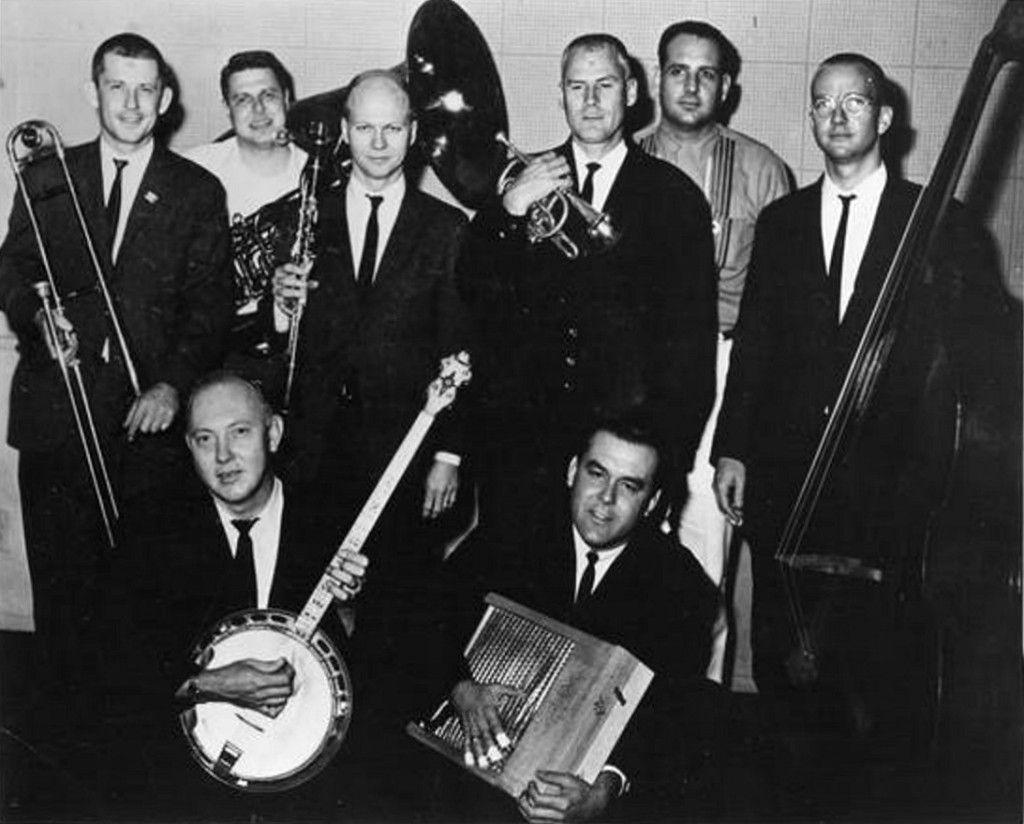
THEN there’s “Cake Walking Babies” (a different way of spelling out the tune title to be sure). During the opening ensemble I gravitated to Mike Baird; his sinewy lines, his tone, his arpeggiations, all that he does during the group choruses is superb. I also grooved on Robin King’s laying down a rock-solid bass line during the verse. Mike Fay’s bass stands out behind Baird’s solo chorus. The vocal blasted out by Ronnei and Crowne is pure id. Neither knows what the other is singing…or cares!! It’s just pure romping joy and I love it. I have to say that while I enjoy Al Crowne’s sheer power, I wish he nailed more of the harmonies. There’s no denying that Papa Ray kicks ass, however!! And when two banjos are complementing each other so well, banjo jokes begone! A great moment for me is hearing the brief discussion regarding where to go next out of the banjo duet: “Verse?” “Yeah, alright…” It shows that this band was happy to mix it up each time they played an old warhorse. Pure, shirt-sleeved spontaneity, the way this music has always been meant to be presented!! It’s rare you hear a band play two final ensemble choruses on this longer-than-usual song and it’s terrific to hear an out-chorus assayed with such abandon. After this one, I can only imagine they all retired to the showers!!
Hal, one of the reasons I love “Dallas Blues” is that it’s one of the too-few songs YOU sing! And I can hear Dan Ruedger’s influence on your delivery. From a chord-player’s standpoint, I should mention how I appreciate the banjo’s use of alternative chords (both here and in “Storyville Blues”). To get a bit “musician-y” for a brief second, you hear Ruedger move from the IV chord in bar 5 of the blues form to a minor iv chord in bar 6 which greatly adds to the poignancy of the sound. It’s a delightful build when Al Crowne comes in to support Mike Baird during his second solo chorus. I’m still trying to wrap my head around Crowne’s trombone style…it’s a bit of, well, lots of players…sometimes Kid Ory, sometimes Turk, sometimes Big Jim Robinson, but ultimately he’s doing himself, and who can argue with that? Finally, I count TWO ensemble choruses before the band heads to two verses and an outchorus, making for FIVE ensemble blues choruses out. HEAVEN!
The next two tunes are a study in contrast. We’ve covered the tune “Panama” in a previous column, but didn’t include the EDJB exuberant interpretation in our discussion, so here it is! On the flip-side, I’d be hard-pressed to find a more soulful version of “Blues, Stay Away From My Door” than the one the band offers here. Before I lay into my personal highlights, Hal, I open the door for your comments.
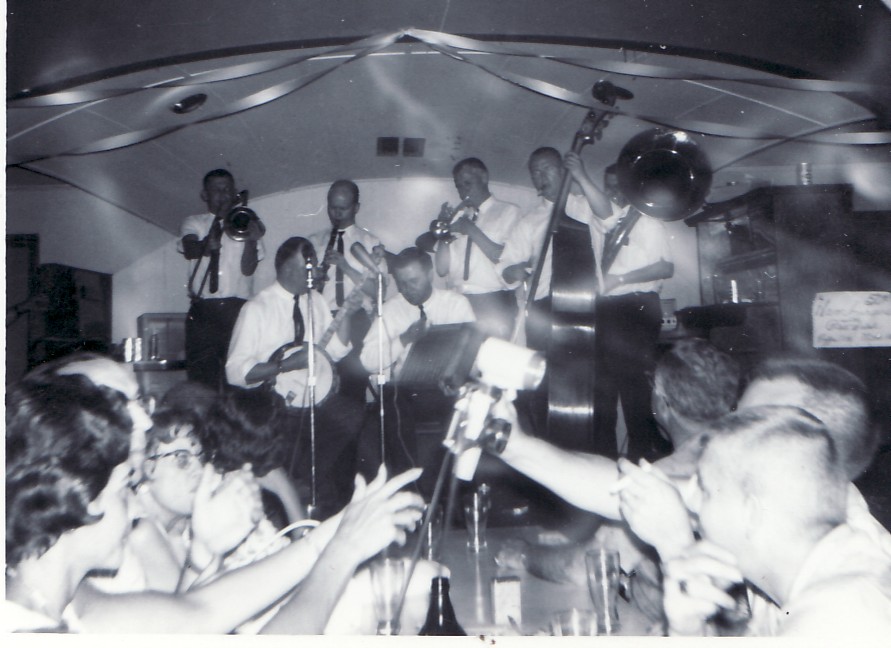
HS: Thanks for correcting me on “Dallas Blues.” As you say, the band DID play two choruses before repeating the verse. I’m still not used to that routine, with two verses so near the end and just one chorus out! The voice on “Storyville Blues” sounds to me like Al Crowne. And there are numerous live recordings of the band (and the South Frisco and Ted Shafer bands) where it’s definitely Ray Ronnei yelling “Awwwww, YEAH!” behind a particularly inspiring solo.
Moving on…”Panama” is played at a typically bright El Dorado tempo. Papa Ray plays that great Mutt Carey-inspired lead all the way through the first trio, with Crowne and Baird playing great ensemble parts. Solos by Baird—with Crowne “goosing” the soloist, as Ory, Big Jim, and Turk did on this same number. Ronnei and Crowne keep the heat turned up on their choruses. Pete Kier is back on helicon, and he solos over the hard-driving banjos. When the ensemble returns, Papa Ray nearly quotes “Salt Peanuts!” He avoids the frequently-used melody on the very last chorus, choosing instead to play freewheeling, hot New Orleans style. I can just imagine what this sounded like in person!
“Blues, Stay Away From My Door” was made to order for Dan Ruedger’s vocal, wasn’t it? The horn solos are not in the usual order (clarinet last) and Al Crowne takes a second chorus before Dan Ruedger re-enters for two more vocals, with some double-time washboard underneath. How about that ending?!? Papa Ray really pulled that one out of the hat!
JB: For my tastes, “Panama” is simply too fast. It’s impressive, and there’s no denying the facility of the players. They lock in, but I think if anyone were trying to march or dance to this, there’d be a battalion of broken legs. That having been said, there are some terrific highlights here as well! I enjoyed the phrase Pap Ray uses on the second strain (“Listen to the Mockingbird”)! I also love how the first two minutes of this track are ensemble and how Ray Ronnei incorporates the all-too-rare skill of leaving space for his fellow frontline musicians. Once the solos start, I wish the rhythm section had backed off a bit so Mike Baird didn’t have to push so much, but he does a grand solo, with Crowne’s trombone support in the second solo chorus urging him on! After Ronnei’s exciting solo, Al Crowne takes his best solo, for my ears, on the CD so far!! Finally, I HUGELY commend Ronnei for eschewing the standard closing melodic figure to keep it hot and fresh! These outchoruses are some of the best I’ve ever enjoyed on this tune! They highlight the iconoclastic nature of this band, constantly reminding you how aware they are of tradition while continuously bending (or even flouting) it!
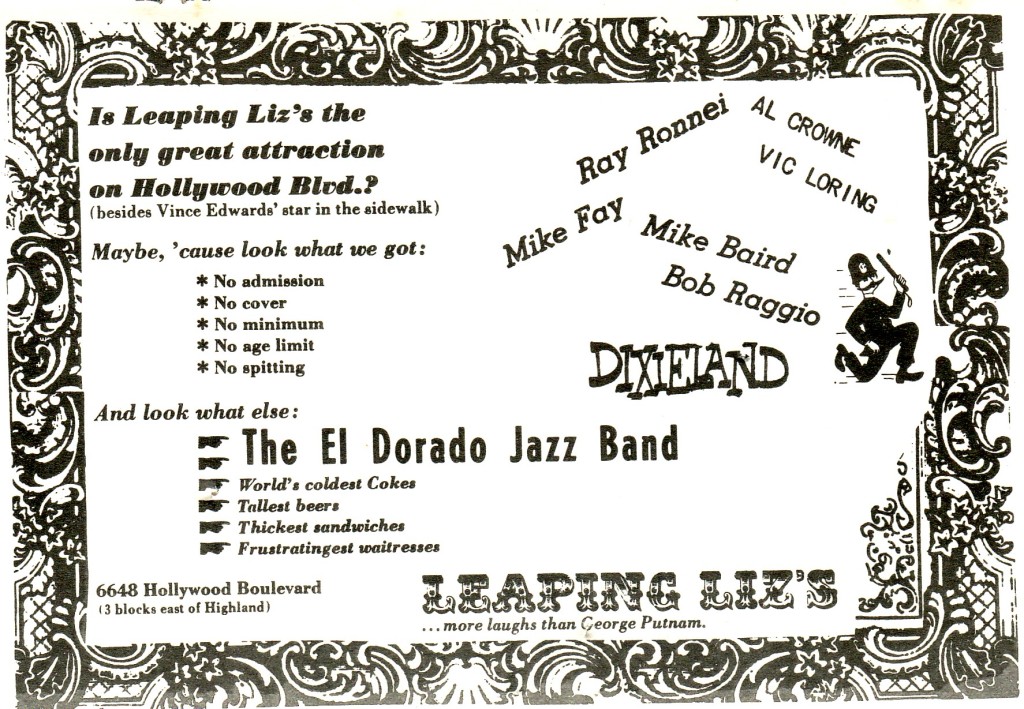
Hal, “Blues, Stay Away From My Door” is one of the most soulful sides I’ve EVER heard from a traditional jazz band. EDJB transcends mere category or label by delivering a dark, melancholic wail. SO nice to have Baird and Crowne sensitively backing Ruedger’s vocal. In spite of the fact that each of the first three choruses speeds up slightly, this minor blues drips sorrow. And Papa Ray’s cornet solo is simply devine. His sobbing phrases send chills into my heart. I dig the varying rhythm accompaniment between Crowne’s trombone solo and Baird’s clarinet solo, which starts with a mewling cry and grows to a full-fledged scream of pain. After two more shouting vocals, the band kicks it in for a final ensemble and I only wish they played two or three more. Yes, Papa’s ending is inspired!
Hal, there’re only two tunes left. Take it away!
HS: The penultimate track on the CD is one of my favorite songs: “Here Comes The Hot Tamale Man.” This is another uptempo romp, with a particularly inspired cornet solo (with a clarinet bridge) and a declarative trombone solo with a Keppardesque cornet bridge. The two banjos of Ruedger and Huddleston play some interesting chord inversions amidst all the strumming. Things go awry briefly on the next-to-last chorus; possibly a miscue regarding a return to the verse and indecision regarding whether or not to play the Charleston rhythm. The last chorus is a bit untidy as well. But then the El Dorado never intended their music to be perfect; just hot!
The album closes out with “Mad Dog,” a variation on Lil Hardin’s “The Last Time” which was recorded by Louis Armstrong’s Hot Five. “Mad Dog” opens with breaks and a minor-key verse that is reminiscent of “Palmer’s Georgia Grind” before the familiar melody of “The Last Time” emerges. Once again, this tune is played at a bright tempo (and I recall Mike Baird’s comment—quoted in our first article). Mike is the only soloist; the rest of the performance features the ensemble. This is a great closing number for our discussion, don’t you think?
JB: A highlight of “Tamale Man” for me is how each horn solo is broken up by the previous soloist taking the bridge—SO…clarinet solo has a trombone bridge, cornet solo has a clarinet bridge, and trombone solo has a cornet bridge. Having not been familiar with this group until you introduced me to them, I first encountered this formula with both the New Black and Golden Eagle(s) Jazz Bands. It’s a simple but potent way to break up the monotony of solo after solo after solo. For the rest, the entire track is joyous, with everyone playing hot! I loved how you indicated that precision took a backseat to heat with this band. The best jazz performances happen when the performers are as surprised as the audience! The final chorus is bubbling with the trademark double ending and I’m craving more!
In a departure from the expected, on “Mad Dog” EDJB starts with a highly arranged—and perfectly executed—intro with two-bar breaks for—in this order—clarinet, tuba, cornet and trombone, and conclude the tune the same way. Hal, I can’t imagine this band ever rehearsed so this must have been one they played often enough to be able to pull off such an intricate intro and outro. During the minor verse, Pete Kiers blasts dancing helicon lines that rock! Yes, this tune is all ensemble, excepting Baird’s clarinet foray, and is the shortest track on the album by 75 seconds. I wish they’d included some more solos or even a couple more ensemble outchoruses. I know you were instrumental in choosing the order of tunes on this release, so I’ll compliment you on your choice: finishing with “Mad Dog” left me barking for more!!
Anyone who has gone the length of listening to the tracks we’ve described above (and why else would you read this column?) is likely wondering where they can here more of this unusual sound within the Trad Jazz idiom. And I know YOU have some suggestions, my friend. Over to you with some exciting news about the latest El Dorado revival!
HS: Of course I encourage our readers to pick up a copy of GHB CD-510. Also, it’s worth checking eBay, discogs.com and CDandLP.com for copies of the El Dorado LPs from the 1960s: Epitaph 3, 4, 5 and Item – 1. AND—to hear a present-day interpretation of the band, my El Dorado Jazz Band will perform at Monterey Jazz Bash By The Bay in March, the Evergreen Jazz Festival in July, the Bix Beiderbecke Jazz Festival in August and the Redwood Coast Music Festival in October. The personnel will vary due to musician availability, but I am very glad that my friend Jeff Barnhart will be on three of those engagements! The other great traditional jazzmen who are going to play with the EDJB in 2024 include Andy Schumm, Colin Hancock, Brandon Au, Dan Barrett, Nathan Tokunaga, Ryan Calloway, Brian Holland, Bill Dendle, T.J. Muller, Bill Reinhart, and Mikiya Matsuda. In addition, the band has a brand-new digital album available on Bandcamp.com with Colin, Brandon, Ryan, Bill Reinhart, Mikiya and the two writers who penned this column. We hope you will check out that album and hope to see you in the audience at our festival appearances!
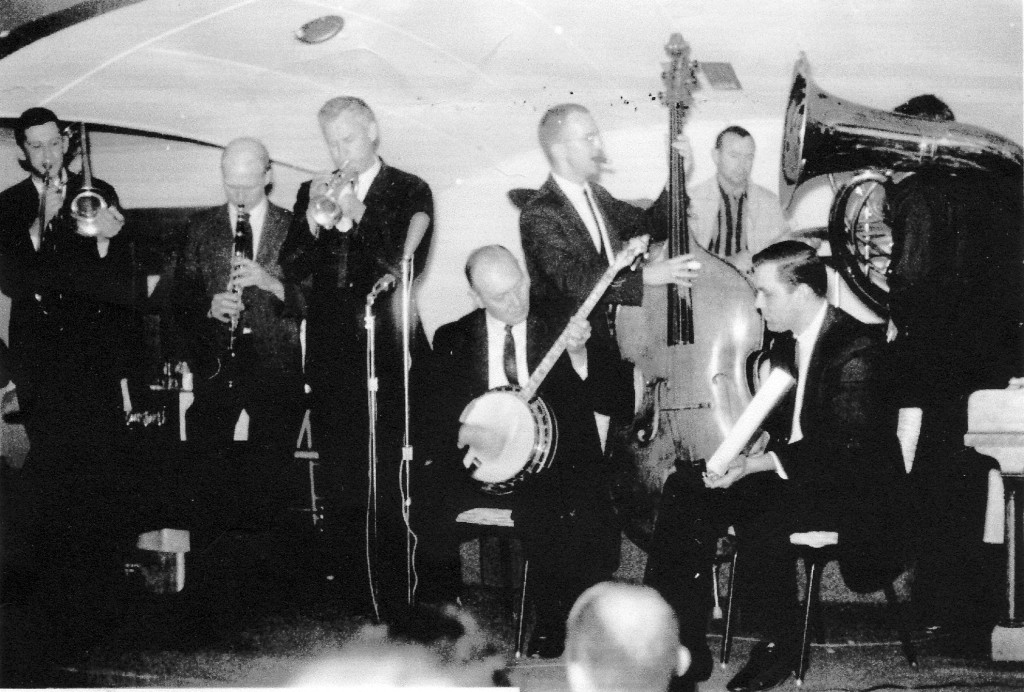
JB: That’s right, Hal!! Once we’ve hit the circuit, hopefully every washboard in an antique mall will be snatched up to start copycat bands!! In the meantime, next month you suggested a pianist with whom anyone my age or younger is most likely only peripherally familiar, but every person I’ve met who heard or played with Bob Greene has gushed to me about the experience with unabashed delight. I can’t wait to listen to the tracks you’ve shared, and know our faithful readers are in for a treat! Till next time!
Jeff Barnhart is an internationally renowned pianist, vocalist, arranger, bandleader, recording artist, ASCAP composer, educator and entertainer. Visit him online atwww.jeffbarnhart.com. Email: Mysticrag@aol.com
Hal Smith is an Arkansas-based drummer and writer. He leads the El Dorado Jazz Band and the
Mortonia Seven and works with a variety of jazz and swing bands. Visit him online at
halsmithmusic.com





